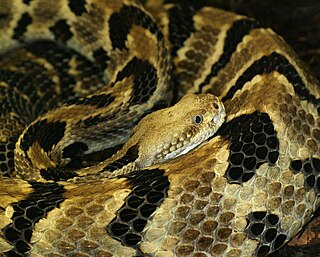
The Crotalinae, commonly known as pit vipers, crotaline snakes, or pit adders, are a subfamily of venomous vipers found in Eurasia and the Americas. They are distinguished by the presence of a heat-sensing pit organ located between the eye and the nostril on both sides of the head. Currently, 18 genera and 151 species are recognized: seven genera and 54 species in the Old World, against a greater diversity of 11 genera and 97 species in the New World. These are also the only viperids found in the Americas. The groups of snakes represented here include rattlesnakes, lanceheads, and Asian pit vipers. The type genus for this subfamily is Crotalus, of which the type species is the timber rattlesnake, C. horridus.

Agkistrodon is a genus of venomous pit vipers found in North America from the United States south to northern Costa Rica. Six species are currently recognized, all of them polytypic and closely related. Common names include: cottonmouths, copperheads, and cantils. Some varieties are known as "moccasins" or "moccasin snakes", such as Agkistrodon piscivorus, the water moccasin.

Hypnale is a genus of venomous pit vipers endemic to Sri Lanka and southwestern India. Three monotypic species are currently recognized. All members have more or less upturned snouts that produce a hump-nosed effect.
Bamboo viper may refer to:

Hypnale hypnale is a venomous pit viper species endemic to India and Sri Lanka. Common names include the hump-nosed viper, Merrem's hump-nosed viper and others listed below at § Common names.

Porthidium is a genus of venomous pitvipers found in Mexico and southward to northern South America. The name is derived from the Greek word portheo and the suffix -idus, which mean "destroy" and "having the nature of", apparently a reference to the venom. As of August 2016 nine species are recognized as being valid. The snakes of the genus Hypnale in southern India and Sri Lanka look quite similar to those of this genus, possibly an example of convergent evolution.
Hypnale walli is a taxonomic synonym that may refer to:
Ancistrodon millardi is a taxonomic synonym that may refer to:

Trimeresurus trigonocephalus, the Sri Lankan pit viper, Ceylon pit viper, Sri Lankan green pitviper or locally, pala polonga, is a venomous pit viper species endemic to Sri Lanka. No subspecies are currently recognized.

Hypnale nepa, the Sri Lankan hump-nosed viper, is a venomous pitviper species endemic to Sri Lanka where it is known as මූකලන් තෙලිස්සා in Sinhala. Earlier thought that Hypnale walli and Hypnale nepa were two distinct species, but it is now accepted that it is the same species and Hypnale walli is a synonym name. Relatively small, they are distinguished by a strongly upturned snout. No subspecies are currently recognized.
Ancistrodon nepa may refer to:
Agkistrodon nepa is a taxonomic synonym that may refer to:
Hypnale walli, Wall's hump-nosed viper, is a venomous pitviper species endemic to Sri Lanka. The smallest member of its genus, it is distinguished by having a strongly upturned nose and lower scale counts. No subspecies are currently recognized.

Kaludiya Pokuna Archeological Forest Site, is a forest with archeological remains in Kandalama, in the Dry Zone of Sri Lanka.

Hypnale zara is a venomous pitviper species endemic to Sri Lanka. It is distinguished from Hypnale nepa by variably colored body and less upcurved snout. No subspecies are currently recognized.
Trimeresurus arunachalensis, the Arunachal pitviper, is a species of venomous pit viper endemic to the Indian state of Arunachal Pradesh. It is only known from the village of Ramda in the West Kameng district, where a single specimen was discovered during biodiversity surveys. It can physically be distinguished by its scalation, its acutely pointed snout reminiscent of the hump-nosed viper, and its brownish dorsal coloration with glossy orange-reddish-brown sides and belly. The last new species of (green) pit viper was described from India 70 years before the discovery of T. arunachalensis. Genetic analysis indicates that the closest relative of this species is the Tibetan bamboo pit viper. The single specimen known of this species makes it one of the rarest known pit vipers in the world, though further surveys of the forest habitat will likely reveal more individuals.
This page is based on this
Wikipedia article Text is available under the
CC BY-SA 4.0 license; additional terms may apply.
Images, videos and audio are available under their respective licenses.








